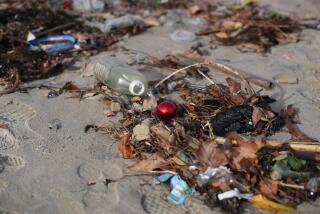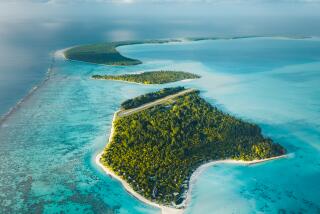Maldives: Paradise threatened?
- Share via
Reporting from Malé, Maldives >>> — Here’s what happens when you travel to the Maldives with someone who followed an Indian guru for 20 years: You find yourself convinced that the dazzling liquid topaz ocean surrounding you is energizing your chakras and healing your inner turmoil. You may not have been aware of any inner turmoil, but apparently most of us suffer it, and isolated tropical islands such as the Maldives are just the sort of place to wrestle it to the ground.
Sally Tagg, a dear friend from New Zealand, was my travel companion and the former guru follower. Former because eventually reality set in, but she still lives her life mindfully. We were in the Maldives not, in fact, to pursue personal satori (enlightenment) but to learn firsthand how enlightened the Maldives is when it comes to being eco.
A string of coral islands lying 3 degrees above the equator in the Indian Ocean and 477 miles west of Sri Lanka, the Maldives has 1,190 islands. Only 200 of the islands are inhabited, home to about 390,000 Maldivians. But here’s the doomsday foreshadowing: The largest of these 1,190 islands is 2 miles long, and most are smaller than a football field. The highest point in all the islands is less than 8 feet. A basketball hoop is 2 feet taller than the whole country.
The Maldives has never been known for much except its idyllic tropical beauty, which appears on screen-savers and posters worldwide. In 2008, however, the watery nation hit the news with a splash. If experts are right and global warming escalates, sea levels will rise and the Maldives will disappear. (We should note that some experts dispute this claim.) U.N. pundits say that oceans could rise as much as 2 feet in the next 90 years. Imagine what that might do to an island the size of a football field.
The Maldives also was in the news because its citizens voted in its first democratic leader, Mohamed Nasheed, 42, a kind of South Asian Nelson Mandela. Nasheed is a young, dashing, educated hero who was imprisoned and tortured by the former president, who reigned with a totalitarian fist for 30 years.
In 2009, while attending the premiere of “The Age of Stupid” (a British climate-catastrophe movie), Nasheed unveiled a plan to make the Maldives the world’s first carbon-neutral nation by 2020.
“Climate change is a global emergency,” Nasheed said, introducing a proposal involving wind turbines, giant solar panels and biomass plant-burning projects. “The world is in danger of going into cardiac arrest, yet we behave as if we’ve caught a common cold.”
There is heartbreaking irony in all of this: The first landmass victim of human rapaciousness could be a place that defines tropical flawlessness, a nation that is clean, peaceful and doing its best to be green. The Maldives is also a favored playground of the rich, including many Middle Eastern sheiks and Russian magnates who made their fortunes on fossil fuels.
And, yes, I came here too, despite being aware that flying here exacerbated the problem. Nasheed’s carbon-neutral plan expects tourist establishments to change their ways, and I was curious to see whether resorts were practicing real sustainability.
The Six Senses by Soneva Gili was our first destination, a 45-room resort that’s 20 minutes by boat from the international airport on Hulhule Island. Six Senses, a Thai company, is known to walk the walk when it comes to social and environmental policies.
Our über-private, two-story eco-chic villa was built on a boardwalk over the lagoon that required no cutting of trees or erosion of land. It was constructed of sustainable materials -- bamboo, old telegraph poles, water hyacinth and palm wood.
Soneva also grows organic vegetables, buys locally from farmers and fishermen, and offsets carbon emissions from guests’ flights by purchasing wind turbines to fuel small villages in India. (This bit helped assuage my guilt.)
The resort also is building a waste-to-methane plant and planning on going solar with a giant sun-tracking dish. And there wasn’t a plastic water bottle in sight. All Six Senses hotels bottle their own water, both sparkling and still, in reusable glass containers. Globally, we produce more than 100 billion plastic water bottles annually, most of which end up in landfills, taking 700 years to decompose.
Our days at Soneva Gili were not spent, I confess, stressing about global warming. Instead we swam, snorkeled, ate organic food and wafted off to the over-the-water spa to be massaged with handmade products.
As the equatorial sun drooped and faded, we’d head to the underground cellar for wine tasting with the Maldivian sommelier, then migrate to the bar to gaze at gaudy purple jellyfish and opalescent Fusiliers through the glass-bottomed floor.
Typically, we would try to engage the Maldivian staff in conversation, which was not always easy. People come here to relax in luxury. Period. The staff members are trained to be friendly, warm and discreet. They seemed confused when we’d ask their opinion on climate change and the chance that their nation could become underwater.
No one is entirely sure where the Maldivian people -- almost all Sunni Muslim -- came from, but it is assumed South India or Sri Lanka. Historically, they were Buddhist. Their language, Dhivehi, is a mélange of Tamil, Sinhalese, Sanskrit, Persian, Urdu and Arabic.
In the 1600s, when rich European nations were falling over themselves to establish colonies, the Portuguese took the Maldives forcibly. The Dutch also had a brief fling with colonialism here, and the French, feeling left out, began meddling in local politics. In the 1800s the British made the Maldives a protectorate (that is, a self-governing colony) and the meddling stopped.
In 1965, the overrun nation finally became an independent republic, but from 1978 until 2008 it was ruled by President Maumoon Abdul Gayoom, who refused to leave office, imprisoned opposition, built lavish palaces and ran the country into the ground. Not until last year did the people throw off the mantle of tyranny. Resort developers, most of whom have a 50-year contract with Maldivian landowners, have since rushed in to add to the more than 85 resorts in existence.
The Banyan Tree Madivaru was the next stop on our Tour of Enlightenment. Set on a 4-acre island, it was one of the most deluxe and sybaritic places I’ve visited. It’s the kind of place you could imagine Sting renting out and doing yoga on the beach in a loincloth.
The resort consists of six tented villas, built on a series of decks above mangrove plants and virginal stretches of sugar-white sand. It’s sort of luxe-safari meets Waldorf Astoria, complete with an egg-shaped, stand-alone bathtub in the vast bathing and changing pavilion, air-conditioning, TV, Internet and pre-loaded iPod. You never see another person other than your villa host and the spa staff, who come to your compound to indulge every whim.
There is much to weigh when judging a place on its environmental impact. Banyan Tree cooked fresh, organic food, but, alas, the resort did have plastic water bottles (I was told the resort was planning to do away with them). No trees were felled in the building of the resort, there’s a waste treatment plant and tents were used so that no permanent footprint would be left on the island.
Madivaru’s boats are four-stroke engines that apparently spew fewer toxins into the environment than standard two-stroke engines. The staff fishes daily, catching only what is needed to feed the guests.
Although sea turtles aren’t overtly concerned with carbon footprints, they will be when there’s no land on which to lay their eggs. Banyan Tree, which has two resorts in the Maldives, established a marine lab that works with locals on sustainable practices, one being planting extra trees in front of each Madivaru villa to minimize light pollution. Thumbs up on Banyan Tree, especially if they lose the plastic water bottles.
The Maldivians we met didn’t seem as worried by global warming as we. When I spoke with Ibrahim Shareef, a villa host at our final resort, the Beach House, he seemed far more concerned about the economic downturn affecting hotel occupancy rates all over the Maldives.
Yes, he told me, he’d seen Nasheed on television talking about the need to go green. He knew about the plan the government has to purchase land in India, Australia or Sri Lanka in case the nation is submerged, but it wasn’t of immediate concern. Of more concern was feeding his family and losing his job at the resort if the tourists didn’t return.
For now, Shareef has a coveted role as villa host at the Beach House on Manafaru Island in the remote north. A large resort, more modern and expansive than the other resorts, it was a different experience with 83 villas and beach-side houses, three bars, three restaurants, a dive center, tennis courts, a gym and an enormous spa.
My favorite part about the Beach House, besides the glass floor in my over-the-water villa living room, was the spa. With black-and-white pebble pathways winding through the flowered jungle, it seemed just the place to exorcise inner turmoil.
The treatment menu was a weighty book of exotic indigenous healing practices. I selected a marma ayurvedic massage because it sounded so bizarre. You lie on a mattress on the floor while the masseuse clings to two ropes dangling from the ceiling. She then massages you with an enthusiastic and highly skilled foot. It felt so shockingly good that I lay there wondering why anyone would use hands for massage.
It would be remiss to visit the Maldives and not scuba dive. The country is known for its impressive sea life. The Beach House, with its untrammeled waters, has some of the best reefs. Although warming waters have bleached the reefs, the spectacle of pelagic and tropical fish was mind-blowing.
The Beach House was about to be taken over by the Hilton World of Astoria Hotels, which has a good record for sustainable practices. Right now the resort is spotlessly luxurious and downright fun, but it seems not to have taken to heart the need to reduce its footprint.
With a capacity for 160 guests, the garbage generated and the boat usage are large, and everything runs on generators. Although no one seemed to be able to tell me about any solid plans because of the management transition, there is hope that Hilton will commit to Nasheed’s carbon-neutral campaign.
But, in reality, what difference will the Maldives’ efforts make to halt global warming? Not much. The planet doesn’t care where people are burning fossil fuels, only how many of them are doing so. About 490,000 Maldivians, most of whom don’t drive, use wind-powered sailboats and grow their own food, will not halt climate change. But their efforts are symbolic. They have a lot to lose.
As do all of us. The thought of a place so rare and spectacular as the Maldives disappearing ought to be enough to fuel a radical effort to change our ways. And we don’t need a guru to tell us how important places of extraordinary beauty are in keeping our inner turmoil at bay.
More to Read
Sign up for The Wild
We’ll help you find the best places to hike, bike and run, as well as the perfect silent spots for meditation and yoga.
You may occasionally receive promotional content from the Los Angeles Times.






